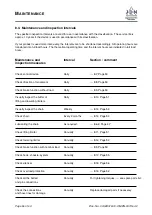
I
NITIAL OPERATION
Check with nominal load
I
Alternatively switch your product
PROFI 25
TI
loaded with a nominal load to lifting and
lowering
If you release a control device, the chain must
come to a standstill in an acceptable time after
the brake has been applied. For physical reasons,
however, the braking distance cannot have the
value zero. The brake has a response time that is
dependent on the control length. A greater control
length increases this response time.
5.5.4. Check overload protection
WARNING
Danger due to overloading
If the overload protection is set too high, imper-
missibly high stresses may arise if a load exceed-
ing the permissible load capacity is attached.
I
Correctly set the overload protection
NOTICE
The overload protection must only be engaged
briefly in order to prevent unnecessary wear and
overheating of the drive.
Rules for running in hoist chains be-
fore carrying out the overload test
NOTICE
In case this information should not be observed
you damage the high tensile chain in your hoist
already during testing prior to initial use for which
the manufacturer does not undertake any liability.
Hoist chains must be run in prior to the overload
test, in order to ensure that the surface pressure at
the contact points of the chain links (in the joints)
can be withstood.
In preparation for overload testing, the following
pre-conditions must be fulfilled:
I
The joints of the chain must be thoroughly
lubricated. Observe the operation instructions.
I
The chain must be run in by raising and lower-
ing it five times with approximately 50% of the
nominal load capacity. This will increase the
load capacity of the joints sufficiently.
I
In particular, the section of the chain to be
tested with the excess load must be thor-
oughly lubricated once again.
Only then can the overload test be performed.
The testing of the overload protection is based on
the attachment of test loads.
1. Attach 125% of load capacity. If this load is
lifted, the overload protection setting must be
corrected.
Page
32
of 64
Doc.-No.: VA049318-10-OM-EN-0319-64-2




































